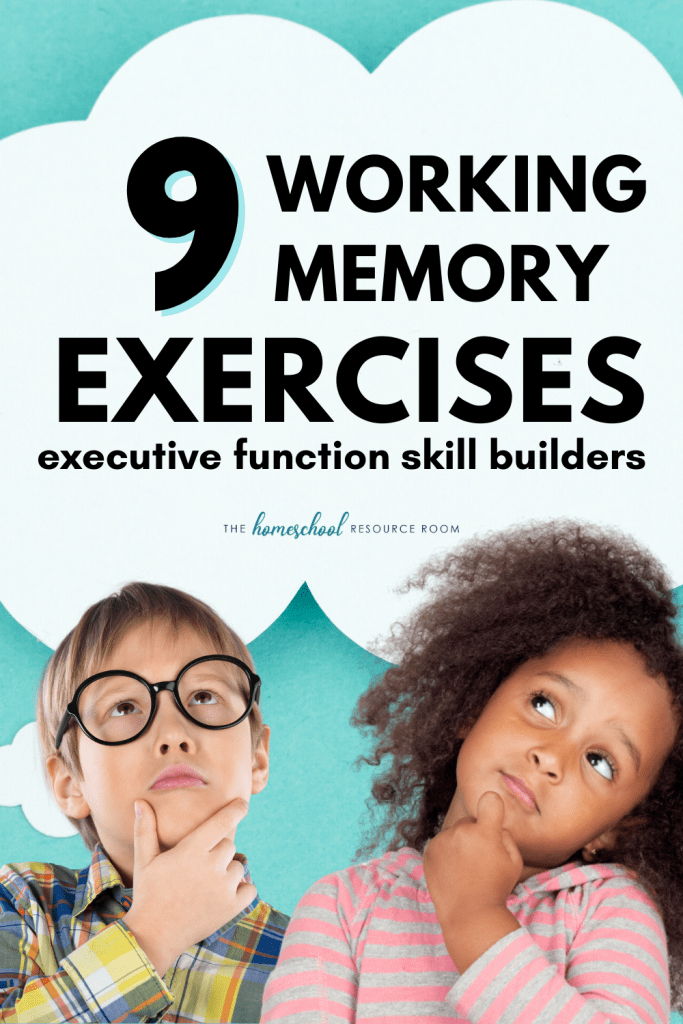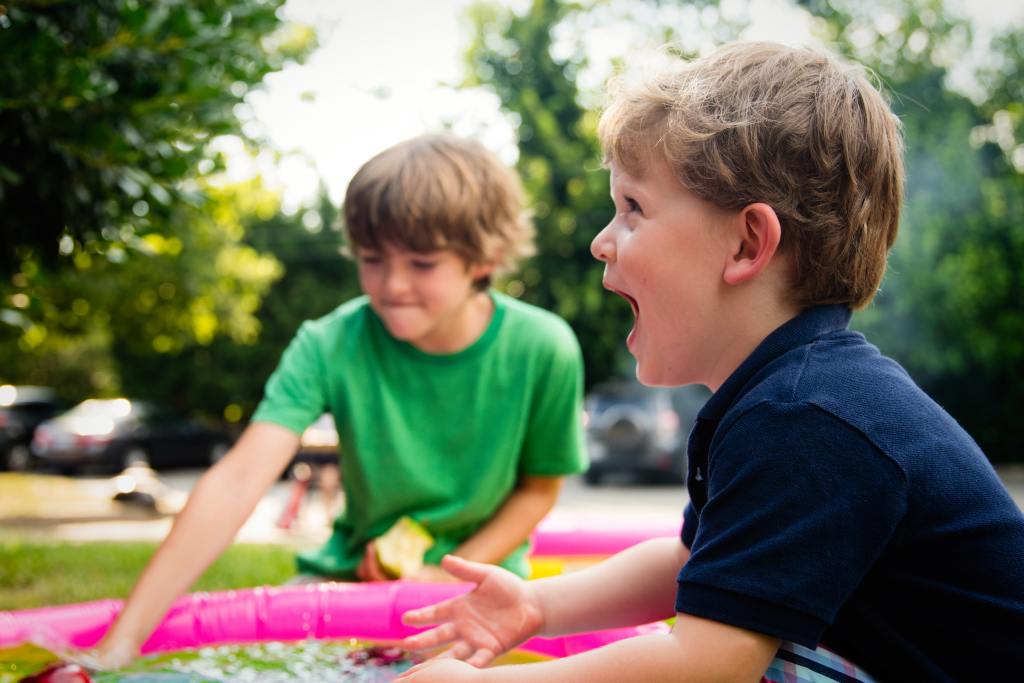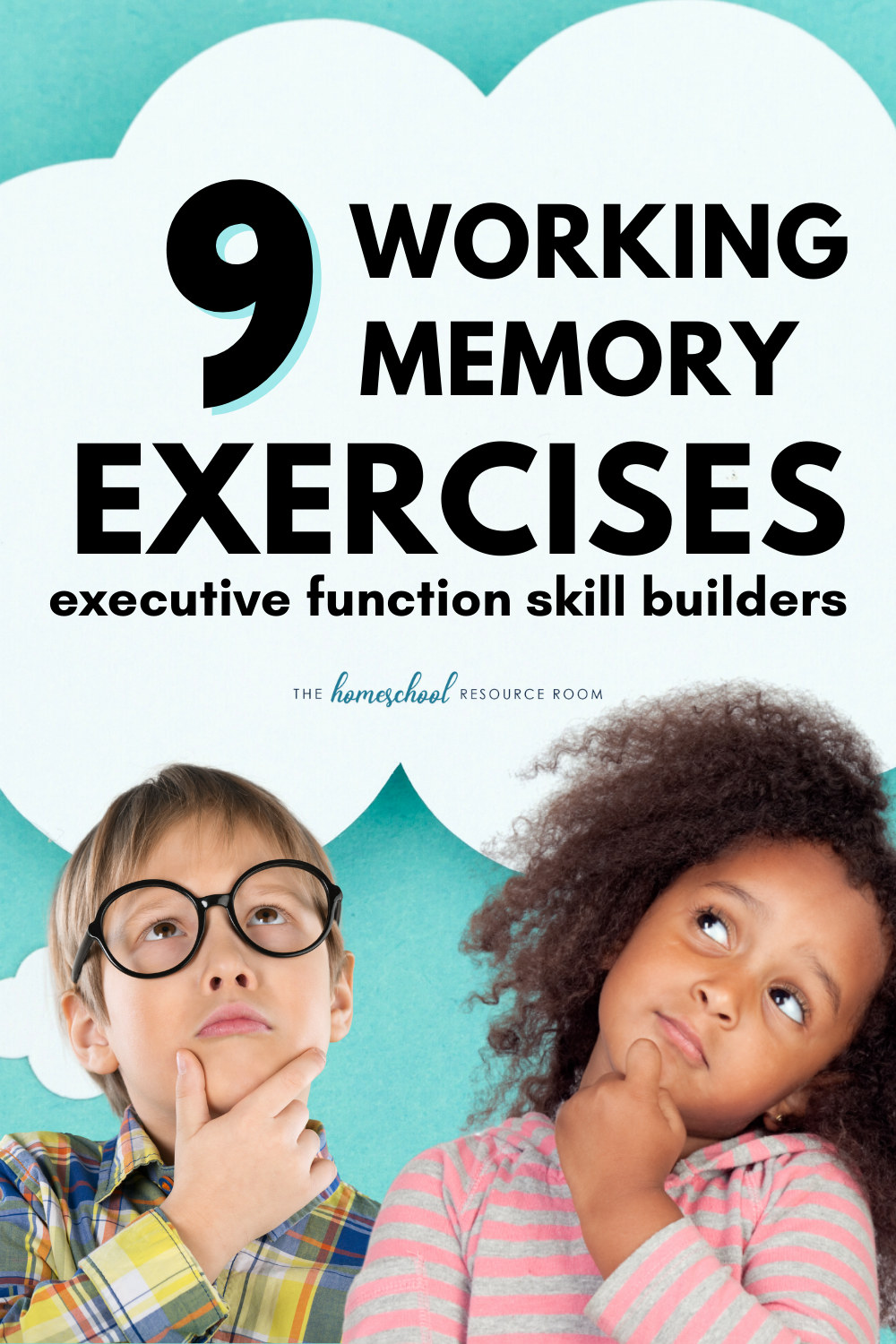This post may contain affiliate links. See our disclosure policy for details.
Tell me if this sounds like a scene at your house, and I’ll tell you whether some working memory exercises might help.
“Jackson, can you please help your sister set the table?”
“Sure, Mom!”
(Ten minutes later)
“Jackson? Why is the table not set yet?”
“Huh?”
Especially for kids with executive dysfunction like ADHD, short term memory problems are common. They struggle to sustain attention, so things they barely hear, respond to, or register never move into the short term storage part of their brain- the prefrontal cortex.

Working memory exercises are designed to improve your child’s ability to hold onto information on a short-term basis. These are ways your child can think about and pay attention to a piece of information slightly longer, which increases their ability to remember it later.
Here’s a collection of my favorite working memory exercises I’ve gathered over the years as a teacher of special needs students and a parent. If you want to try other activities to boost your child’s executive functioning abilities in other areas, check out the executive functioning activities masterlist.
Academic Working Memory Exercises
Kids with executive dysfunction often really struggle with math and reading. Math relies heavily on memorized shortcuts like what 5+4 is or the system for solving an equation. Reading requires sustained focus and integrating lots of information at the same time.
One of the most common complaints I heard in my mostly special needs classroom was this. “I know how to read, but by the time I reach the end of the paragraph, I’ve forgotten what I read at the beginning.”
It can be frustrating to kids when learning doesn’t seem to come as quickly to them. Therefore, I like to use many of these working memory exercises with entire classes (either in schools or homeschools) to reduce any stigma. It can’t hurt the kids who would have learned anyway, after all. So with that out of the way, here are some of the most successful strategies I had in solving working memory problems with students.
Acronyms and Other Mnemonic Strategies
Research has shown that using mnemonic devices can seriously improve your student’s working memory game in the classroom.
Acronyms are a great beginning, and you probably already know some from your own time in school. PEMDAS (to remember the math order of operations), HOMES (for the five Great Lakes), and PAPA VINC (for the 8 grammatical parts of speech) come to mind.
You also can use acrostic sentences. The “Never Eat Soggy Waffles” way of remembering the four cardinal geography directions is a common one. So is “Every Good Boy Deserves Fudge” for the five notes of a treble music staff.

Graphic Organizers
Writing takes longer than talking or taking a picture of information. This is part of the reason it’s so good for boosting working memory. The longer you pay attention to something, the better chance you have of remembering it and using it. This is why I always required my students to practice taking notes in class, and not just let them take a picture of my notes from the board.
Graphic organizers are also a great way of helping kids look at and manipulate information. Firstly, because it means they get to see all the info laid out at once. This is great because then they don’t have to remember all five or six pieces at the same time. Secondly, seeing information (as opposed to just thinking about it or hearing it) means they can go back and read it over and over. As many times as they forget it, they can go back and instantly retrieve the info! And that also goes for directions too. No more forgetting what your instructions were if it’s all laid out on the paper!
Make Up Songs
I’ve talked about this before, but I think making up songs is one of the most underrated working memory exercises for elementary-aged kids. We tend to think of it as something only belonging to preschool and kindergarten, and that older kids are ‘too cool’ to sing songs. However, it works! That’s how classroom institutions like Schoolhouse Rock are still around after all these years.
First, pick the melody of a song your child already likes, whether it’s from a children’s song or popular music. Then, change the lyrics to fit with the subject they’re trying to learn. (If you’re really creative, you could make up a whole new melody, too.) I’ve seen this done to memorize the names of all the human bones, state capitals, and even the steps to solving for X.
Visual Cues
There was a reason school teachers have walls covered in posters, schedules, and academic images. Visual cues are hugely important in helping kids ‘hang onto’ pieces of information. Check out these Editable Visual Routine Posters for some helpful visuals to add to your morning and evening routines.
Working Memory Exercises

Give Them a Minute
One of the hardest things for kids with ADHD, Autism, or other executive functioning problems is speed. How often do we ask our kids where they put something, why they haven’t gotten dressed, or a thousand other questions- and expect nearly instant responses?
Kids with poor working memory might be able to retrieve the information you need if you simply wait. Make it a habit of mentally counting to three, five, or ten before rephrasing your question or prompting a response. Generally, your kid actually wants to give you an answer, and would be happy to offer one if given a second to think.
Also, make the ‘wait’ part of your daily life. The only thing worse for a kid than not immediately knowing an answer is feeling “dumb” for taking a little longer than others. Perhaps offer the same wait time times when you ask questions to the checkout lady, other children, or teachers.
Visualize It
Sometimes, the best way to override a poor working memory is to go through the back door. Using a mental “sense of sight” can help a child cement a memory better than auditory directions or a mental ‘to-do’ alone. When you tell your child to pick up after themselves, feed the dog, or do their homework, have them take five minutes and visualize the activity. They can describe it out loud to you, too. In fact, verbally walking through the steps of the activity can help with their prioritization skills, too.
If your child struggles with doing the visualization on their own, you can turn it into a guided walk through. “Close your eyes. Now imagine yourself sitting at your seat and grabbing your notebook. Then, imagine yourself opening your workbook to the chapter on the Jurassic Period.” You get the idea! Visualization is also a great activity for children with anxiety, as well.
The Categories Game
I like this activity because it doubles as “clean all the random toys off the floor” day! To play, grab a collection of 10-20 toys of various origins. Then, have your child organize them into different categories. You might try having your child line them up by size, grouping by color, shape, alphabetically, whatever. This is one of the best working memory exercises because your child needs to quickly shift how they think. They might start by thinking about the objects one way (say, by their color), but then they’ll need to immediately discard that system for a new one.
If it seems like too hard a challenge, reduce the number of objects to 3-5, or only do a handful of different organizational methods at a time. You can always build up to higher or more complicated games once they’ve mastered simpler ones!
Routines: The Most Important of All Working Memory Exercises
Is there anything more important to a kid struggling with their working memory than establishing routines? I think not. Routines are basically you helping your kid develop a behavioral autopilot that doesn’t require working memory. This frees up their brain space for focusing on other activities and helps them get more done better.
For some practical tips, I’ve already written about ADHD routines if you want help establishing them up in your home.
For more reading on this topic:
- Homeschool ADHD Schedule: 13 Hacks + A Sample Schedule
- Accommodations for Autism: 21 Best Recommendations
- Help My Child Focus Naturally: 5 Tried and True Strategies
- Accommodations for ADHD: 25+ Tips & Recommendations

Hillary is a former teacher who went rogue and became a freelance writer. When not offering support and advice to homeschooling families, she tends to her own garden, family, and cat. You can connect with her on her website, homegrownhillary.com.

